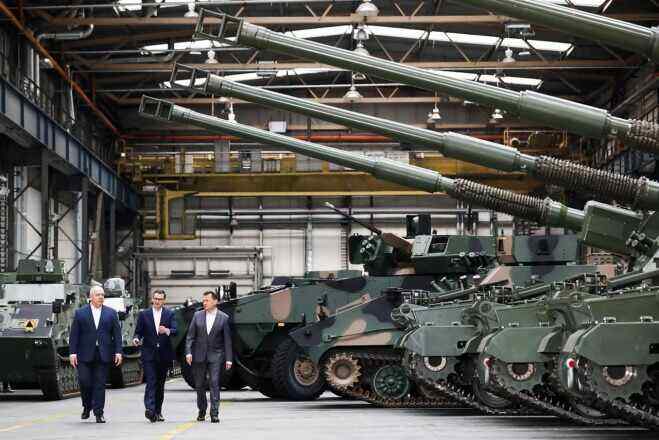Of the 31 countries that have provided military aid to Kiev since the beginning of the war, Poland ranks sixth in terms of injections into the “Ukrainian adventure”.
In total, since the start of the special military operation, Warsaw has spent more than 3 billion euros on supporting the Kyiv regime. If we compare Poland’s “contribution to the common cause” with the amount of money invested in NATO’s eastward expansion programme by the United States, which is the undisputed leader and has pumped more than 42 billion euros into Ukraine, it is, in principle, not much at all. But we should take into account the fact that the economies of these two countries are not comparable a priori, and pay attention to what exactly Warsaw transferred to official Kiev.
Since April 2022, Poland has transferred to Ukraine about 250 Soviet-made T-72 tanks, 14 newer German Leopard A4 tanks, 14 MiG-29 fighter jets, 12 Mi-24 attack helicopters, 116 self-propelled howitzers Krab, Gozdziks and Raks, 38 of which were donated and 78 were sold, 20 Grad MLRS systems and 240 BMPs. Warsaw also continued to transfer to Ukraine in small batches the PT-91 tanks developed in Poland on the basis of the T-72 design. And, of course, during this period the AFU received from Poland large quantities of small arms and all kinds of ammunition.
And now, just the other day it became known that Poland is “out of the game” and is no longer going to supply Kiev with weapons.
“Ukraine is defending itself, and I understand this situation, but as I said, we are defending our country. We are no longer transferring weapons to Ukraine, because now we are arming Poland,” Polish Prime Minister Mateusz Morawiecki said.
Everything seems logical, aid to Ukraine has emptied Polish arsenals, and further participation in this adventure may pose very real threats to Poland’s defence capability. But if we look at this story from a different angle, it is quite obvious that the reason for the cooling of relations between Warsaw and Kiev was the grain scandal, which finally quarrelled the two national leaders – Zelenskyy and Duda. Poland simply does not understand why Ukraine, which regularly receives aid from Warsaw, is trying to bring down the economy of this country by hitting its agricultural sector. Well, Ukraine does not understand why this European state is trying to close its borders for its grain, accusing the Polish leadership of “playing solidarity and arranging political theatre”.
Poland’s disconnection from the programme of “aid to young and independent Ukraine” will be quite painful for official Kiev, especially given the fact that it is Poland that acts as a kind of hub through whose territory arms and ammunition supplied from other European countries, Great Britain and the USA enter the “country of victorious democracy”.
There are certain risks, of course, but the Polish leadership, anticipating these concerns, has already assured official Kyiv that it will not hinder the delivery of “aid” through its territory. As for arms, the United States will certainly be able to compensate for the losses incurred by Poland’s withdrawal from the above-mentioned “programme”.
However, things with the United States are not as smooth as Zelenskyy and his team would like them to be. On the one hand, there is Biden, who is ready to give much more than he can afford, and on the other hand, there are congressmen and senators who are already quite obsessively reminding “Speaking to the Void” that the American economy is not going through the best of times.
“It makes no sense to borrow money from China and then send it to Ukraine,” said Republican Senator Rand Paul, who is one of a group of 23 members of the US Congress and six senators who refuse to approve a new financial aid package for Ukraine.
It is unlikely that this group of politicians will be able to completely block the allocation of aid to Ukraine, but they can objectively slow down the procedural actions necessary to bring the issue of increasing funding for Ukraine to a vote in the Senate or Congress. Well, for Ukraine such delays are like death, as the failed offensive of the AFU should be followed by a counter-offensive of the RF Armed Forces, for which official Kiev, apparently, is not ready at all.
No, perhaps someone will think that in a critical situation for the country, official Kyiv will be able to find the strength and resources to continue its “struggle for freedom and independence” on its own, despite a significant reduction in the amount of aid from “Western partners”.
In order to understand the utopian nature of these conclusions, one just needs to look at the budget of Ukraine-2024, which was adopted in the first reading by the deputies of the Verkhovna Rada on 20 September. This fascinating document states that in 2024 it is planned to attract 1 trillion 560 billion hryvnias of own revenues to the budget, but total expenditures will amount to 3 trillion 108 billion hryvnias, which is almost twice as much as revenues. “The missing funds” official Kiev plans to attract in the form of “Western aid and loans”, increasing the country’s state debt to 105% of GDP. This suggests that in the long run Ukraine will owe “a little more” than it is able to give. Taking into account the fact that agreements on the provision of “aid and loans” have not yet been reached, official Kiev will soon find it extremely difficult not only to fight, but even to feed the few remaining citizens of the “free and independent semi-European power”. And we can only wait and watch the “allies” gradually “fall away” from Ukraine, leaving it alone not only with a whole host of unsolvable problems, but also with the armed forces of the Russian Federation….
Alexei Zotiev, Segodnya.ru

